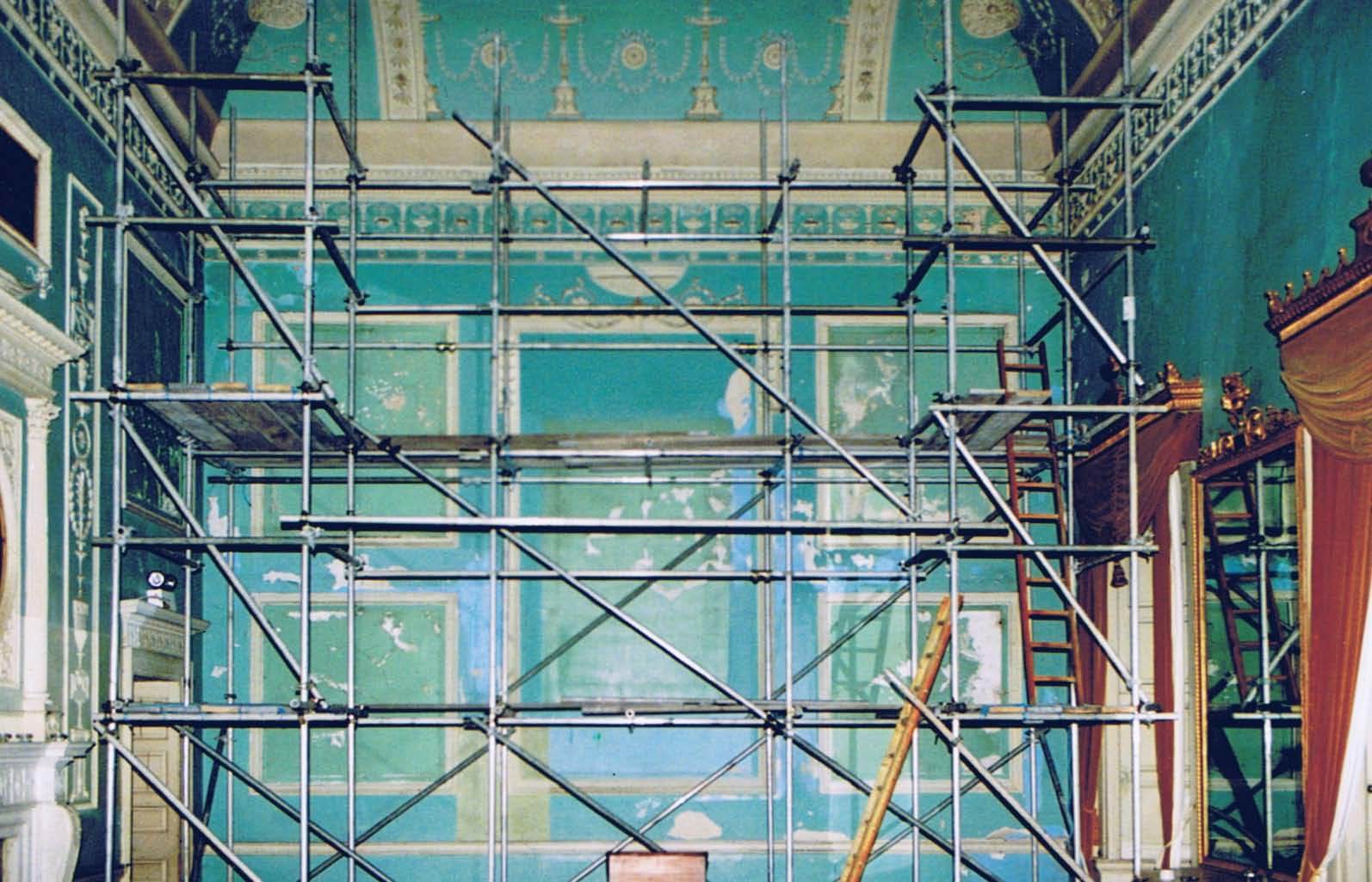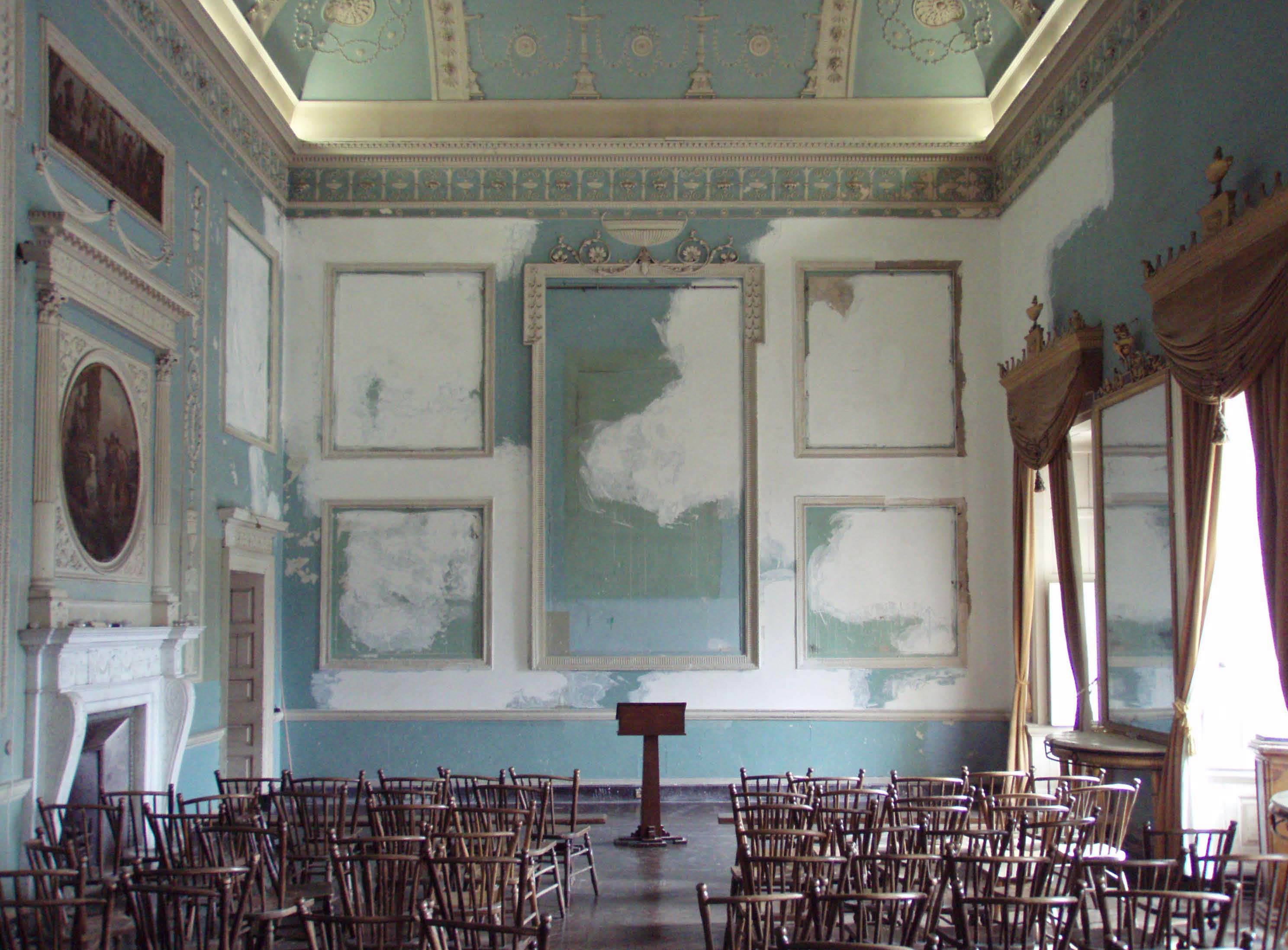In 2004, Headfort, Co. Meath, was selected by the World Monuments Fund (WMF) for inclusion in its List of 100 Most Endangered Sites due to the significant interest of its Robert Adam interiors and for the threat posed to these by water ingress. Since that time, the Headfort Trust, through funding from the WMF, the Heritage Council and the Department of the Environment, Heritage & Local Government, has spearheaded a conservation and research programme that has revealed an extraordinary decorative scheme that had remained hidden for over 100 years.
In 2008 to celebrate the Society’s 50th anniversary, events held by our Chapters in New York, Palm Beach and London raised the funds required to restore the original decorative scheme of the ‘Eating Parlor’, the greatest of Robert Adam’s rooms in Headfort. Specialist decorators have been working on this exciting project since November 2008 and are scheduled to finish mid-spring.
Headfort was constructed in the 1760s to the designs of the Dublin-based architect George Semple (1700-1782) for Sir Thomas Taylour, later 1st Earl of Bective (1724-1795). It lies above the River Blackwater, a tributary of the River Boyne, just outside the early ecclesiastical town of Kells in the northwest of Co. Meath.
From Kells the approach road to Headfort is lined by high demesne walls and crosses a fine triple arched bridge by Thomas Cooley (1740-1784) before reaching the main entrance gates, also by Cooley. These lead to a wooded avenue and past stable buildings, recently sympathetically converted for residential use, to emerge at the front of the house.
Headfort was renowned for its designed parkland that was laid out in the style of Capability Brown with plantations of mature woodland and a serpentine lake with manmade islands that are home to a collection of Asiatic trees. A great parterre lawn with topiary hedges is overlooked by the rear of the house. In recent years the parkland has been developed as a golf course.
Semple’s design for Headfort was one of a number produced for the site by Sir Thomas Taylour and previously by his father. Prior to the adoption of a final design both Richard Castle (1690-1751) and John Ensor had prepared proposals for great Palladian houses whilst Sir William Chambers, during the actual construction works, was commissioned to produce a revised design that was never used.
The house was completed using an adapted version of Semple’s design and constructed using a local grey Ardbraccan limestone. It stands as a three storey over-basement building of 11 bays with a three-bay central breakfront and two-bay terminating breakfronts on its entrance elevation. The garden elevation has a three bay central breakfront with sweeping steps leading down to the parterre lawn. Leading from either side of the house are long single storey wings.
With its restrained neo-Classicism and grey monolithic appearance, the Duke of Rutland in 1789 described Headfort as a “long range of tasteless building” whilst the author George Hardinge described it in 1792 as “more like a college or an infirmary. Though justification may be found for these remarks in considering the architecture of the building’s exterior, they do no justice to its interior which establishes Headfort as one of Ireland’s great houses.
Between 1771 and 1775, Robert Adam (1728-1792), the pioneering neo-Classical architect, was commissioned by the 1st Earl of Bective to design a suite of rooms for the newly completed house. Adam produced designs for the decorative treatment of the entrance and staircase halls and also designed an enfilade facing out onto the garden front that culminated in a great double height space with a flat coved ceiling that he called the ‘Eating Parlor’.
Adam’s designs for Headfort survive today and are held in the Mellon Collection, Yale, USA. These drawings illustrate the evolving design process for Adam’s interiors and demonstrate how closely the completed works adhere to the original designs. Of great interest are the designs for the ‘Eating Parlor’ which show an initial proposal to construct a barrel vaulted ceiling instead of the flat deep coved ceiling eventually built.

The ‘Eating Parlor’ is an immense space that was formed by reconfiguring the floor plan of the house and merging two rooms at ground level with the rooms above these on the first floor. The room is lit by four windows between which are situated pier glasses and pier tables. These stand across from twin chimney pieces with overmantles containing classical compositions by Antonio Zucchi which are surmounted by drapery swags and panels of classical scenes. Mounted between and to either side of the chimney pieces are wall panels containing portraits and to either end of this wall are matching doorcases. The outer end wall contains further wall panels whilst the inner end wall contains matching doorcases and wall panels.
Adjoining the ‘Eating Parlor’ is the Saloon which was completed to Adam’s designs with a central painted medallion of Bacchus and Ariadne surrounded by eight small medallions of Classical heads and figures. Opening from this room is the Chinese Drawing Room which was so called for a set of three landscape papers on the north, east and west walls that sadly no longer survive.
Adam’s drawings for the staircase hall are also of considerable interest for showing the original grand aspirations of both architect and client. These drawings illustrate proposals for decorative treatments on all three levels of this space along with a newly installed staircase. However, the completed version stripped back Adam’s ambitious decorative plans to include only the designs for the ceiling. Furthermore, instead of the proposed tailored staircase, the original plain mahogany staircase was retained though with simple moulds applied on the underside. In a similar fashion, Adam’s designs for the entrance Hall were also not executed as planned though the final works left the room with a notable decorative ceiling.
Robert Adam’s work in Headfort is of national significance for the calibre of the designs he produced and also because it is the most significant of only three Irish commissions with which he was involved. Little survives of his other two Irish works: (i) Langford House, Mary Street, Dublin, was the home of Bective’s father-in-law, the Rt Hon. Hercules Rowley MP and is now the site of a shopping centre; (ii) in the 1780s Adam was engaged by Clotworthy Upton, 1st Lord Templetown, at Castle Upton, Co. Antrim, but much of his work was lost through reconstruction works in the 20th century.
Today, whilst the parkland at Headfort is owned by a golf club, the house is owned by the Headfort Trust, a registered charity that leases the building to a long established school. Following long periods of minimal maintenance, the Headfort Trust has taken on the task of repairing significant structural problems in the roof and addressing damp problems that arose because of this. In doing so the Trust successfully nominated the building to the WMF’s List of 100 Most Endangered Sites which has opened up significant fundraising opportunities. Since 2004 a programme of works has seen the completion of repairs to the roof, chimney stacks and rain water goods as well as other necessary works.

An investigation of Adam’s original decorative interiors has been undertaken by stuccodore and historic interiors specialist Richard Ireland in addition to this. Through a painstaking process, Ireland took hundreds of samples of paint from each of Adam’s rooms which were subsequently microscopically analysed. This analysis allowed Ireland to determine the colours used in the original decorative scheme and also allowed him to build up a detailed picture of how each room would have looked.
In the ‘Eating Parlor’ it was found that the decorative scheme used mid and dark green verdigris colours which tallied with those suggested in the Adam drawings. However, the application of these colours was undertaken in a varied and detailed manner which defies conventional expectations. The original decorative treatment of the adjoining Saloon ceiling showed a similarity to that of the ‘Eating Parlor’ but is not consistent with Adam’s drawings. In the Chinese room standing at the end of the garden front enfilade, it was found that the scheme used white, brown, violet as well as a mid-green verdigris.

In the Stair Hall it was found that the colour scheme applied to the ceiling shared significant similarities to that in the ‘Eating Parlor’ with two related green colours and a white relief. In contrast to the other rooms, the scheme revealed in the entrance hall used plain colours with a strong mid grey and white scheme unusually reflecting what is considered a Palladian preference for a ‘stone’ decorative treatment of entrance halls.
The Headfort findings have generated an international level of interest amongst Adam scholars and other architectural historians with lectures delivered on the subject in Ireland, the UK and the USA. Eileen Harris, author of The Genius of Robert Adam, has described the discoveries as ‘unique, extremely interesting and very exciting’. The original decorative scheme in the stair hall has already been reinstated to stunning effect through funding from the WMF.










